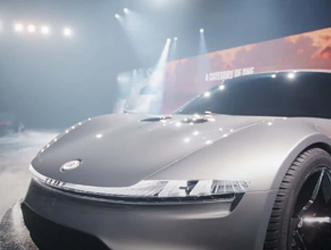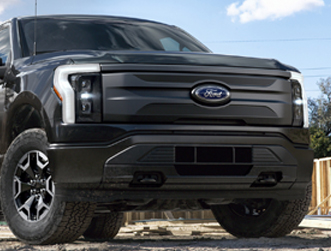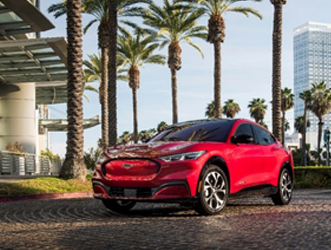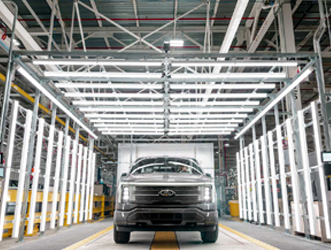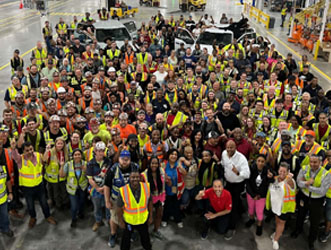Fisker Unveils 4 New Upcoming EVs
Written by Suvrat Kothari, InsideEVs
Published Aug. 5, 2023
Fisker made a big splash Aug. 3 during its Product Vision Day 2023 event by revealing four new electric vehicles that will join the Ocean SUV in the next couple of years.
Taking center stage during its live event was the Ronin flagship electric supercar with 600 miles of range. It would be a "technology carrier" for showcasing innovations. Additionally, Fisker also revealed the Pear compact electric hatchback for the masses, Alaska pickup truck and an adventure pack for the Ocean called the Force E.
The brand also revealed its new supercomputer that will debut on the Pear. Reservations are open for all the announced models.
Fisker Pear
The most anticipated reveal was arguably the Pear, an acronym for "Personal Electric Automotive Revolution." CEO Henrik Fisker said the compact EV will start at $29,000 and be eligible for federal incentives, which would drop the price to $22,400.
The U.S.-made EV will ride on the SLV1 platform, an abbreviation for simple, versatile and volume. It's a "steel plus plus" platform and uses 35% fewer parts. The dual-motor all-wheel-drive EV will get a range of around 300 miles. But don't expect it to appear on American roads any time soon---the launch timeline is mid-2025.
Cool design elements at the rear include a wraparound LED taillamp and what the brand calls the "Houdini trunk"---it rolls down and disappears into the rear bumper, which Fisker said could be useful in getting items in and out easily when cars are parked closely on tight city streets.
Fisker will offer the Pear in five- and six-seat configurations, with the latter getting a bench seat up front to sit three abreast. The brand plans to sell 1 million units of the Pear annually but stopped short of mentioning the timeline for that target.
Fisker Ronin
Another exciting reveal is the Ronin, which the brand calls the world's first four-door convertible. The hand-built EV will flaunt a carbon fiber hardtop, and availability will be limited. Its silhouette is somewhat of an ode to the Fisker Karma, the brand's first-ever vehicle that launched in 2012 and was soon discontinued.
The future TeslaRoadster rival appears striking with its low-slung stance, full-width front headlamps with an embedded illuminated Fisker brand logo, sculpted wheel arches and scissor doors. To maximize aerodynamic efficiency, it will have active aero flaps as well. It has four doors and is a five-seater.
The electric luxury GT will have a cell-to-chassis battery, eliminating packs and modules, which would enable 600 miles of range. The all-wheel-drive EV will feature a tri-motor set-up and deliver an output of more than 1,000 horsepower, with a 0-60 mph time of just 2 seconds.
The Ronin is expected to launch in the U.S. by the end of 2025.
Fisker Alaska
Fisker will enter the fast-growing electric pickup truck space with the Alaska. The electric truck market is currently occupied by the likes of the FordF-150 Lightning, RivianR1T, GMCHummer EV and ChevroletSilverado. Fisker claims the Alaska will be the world's most sustainable and lightest truck.
It is built on the FT31 platform, a modified and stretched Ocean platform. It will slot somewhere between a compact and a mid-size pickup truck.
At first glance, the electric truck appears to have the silhouette of a Hyundai Santa Cruz---its raked C-pillar slopes into the bed, and the design is an evolution of the Ocean SUV. The Alaska has a 4.5-foot bed, which extends to 7.5 feet, partly thanks to another "Houdini trunk," which in this application is a midgate that completely rolls down.
With the rolled-down midgate and an opened trunk gate, the bed's length increases to 9.6 feet. Customers will also be able to fold the rear seats flat, and open up additional room.
The expected driving range is between 230 and 340 miles, and it's likely to use the Ocean's battery and power units. The Ocean gets a maximum range of 440 miles on the WLTP cycle, thanks to 113 kilowatt hours of battery capacity.
The CEO demonstrated how the truck's center console houses the world's largest cup holder, which appeared to hold a 1-gallon bottle. Another quirky feature is a "cowboy hat holder" above the rear seats, alongside the usual suite of features like California mode seen on the Ocean.
The Fisker Alaska will cost $45,400 before incentives, and will likely qualify for the federal tax credit that could drop its starting price to $37,900. The production version is expected to roll out in December 2024.
Fisker Force E
The brand also unveiled an adventure-ready Ocean called the Force E. It rolled on the stage draped in a matte black paint, with chunky 33-inch off-road tires and 21-inch aluminum aero wheels, extra wide fenders and a massive roof rack. The Force E is an add-on package that existing Ocean customers and reservation holders can buy.
Additionally, it packs the usual suite of off-road features that adventure junkies would expect, including higher ground clearance, a protective underbody plate, structural front and rear skid plates, along with special dampers and improved approach and departure angles. The package will be available in early 2024, and pricing will be revealed closer to that time frame.
Blade Supercomputer
The Pear's brain will essentially be a supercomputer called Blade, which looks like a tiny box but appears to pack a lot of capability. It can deliver an insane computing speed of 6.2 teraflops. For reference, one teraflop can deliver 1 trillion floating point operations per second.
It's upgradeable and supports multiple functions like 5G, Wi-Fi and multi-gigabit ethernet---Fisker said it will be a mini data center on wheels. The Ocean's architecture uses eight primary domain controllers, while the Pear will use just two high-performance controllers.
Another notable aspect is the supercomputer will enable high-quality graphics renderings and artificial intelligence capabilities, which can "predict failures before they occur."
Fisker is still a new brand, and it hasn't fulfilled production promises for the Ocean, its first BEV. The brand missed production targets for both Q1 and Q2 2023, while its operational losses continue to mount. Its Q1 2023 net losses equaled $120 million. With three new EVs on the horizon, it's likely an uphill task for the company to ramp up production and make the new products a reality.
We thank InsideEVs for reprint permission.













